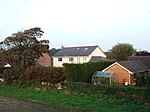New Cut Lane Halt railway station
Disused railway stations in the Borough of West LancashireFormer Lancashire and Yorkshire Railway stationsHalsallNorth West England railway station stubsPages with no open date in Infobox station ... and 3 more
Railway stations in Great Britain closed in 1938Railway stations in Great Britain opened in 1906Use British English from June 2013
New Cut Lane Halt was a railway station between Shirdley Hill and Halsall in Lancashire. The station opened in July 1906 as a halt on the Liverpool, Southport and Preston Junction Railway, and consisted of simple cinder based platforms at track level. It was situated to the south of the roadbridge on New Cut Lane, to which it was connected by wooden steps. The station closed to passengers on 26 September 1938 and the tracks were lifted shortly after the line closed in 1952.
Excerpt from the Wikipedia article New Cut Lane Halt railway station (License: CC BY-SA 3.0, Authors).New Cut Lane Halt railway station
New Cut Lane, West Lancashire Halsall
Geographical coordinates (GPS) Address External links Nearby Places Show on map
Geographical coordinates (GPS)
| Latitude | Longitude |
|---|---|
| N 53.5966 ° | E -2.9667 ° |
Address
New Cut Lane
New Cut Lane
L39 8SP West Lancashire, Halsall
England, United Kingdom
Open on Google Maps








